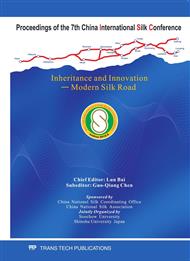p.236
p.242
p.247
p.253
p.258
p.266
p.272
p.276
p.280
Synthesis and Characterization of Novel Silk-Like Proteins Using Genetic Engineering Methods
Abstract:
Using genetic engineering methods, we attempted to produce novel silk-like proteins with new function by combining several functional sequences selected from fibroin of Bombyx mori (B.mori), Samia Cynthia ricini (S.c.ricini) and spider silks or by inducing cell adhesive sequence or calcium binding sequence into silk proteins. The secondary structure of these silk-like proteins was characterized with solid state NMR. Cell adhesion assay indicated that silk-like proteins have higher cell activity. Mineralization of fibroin protein was improved with induction of calcium binding sequence. Nanofiber formation of silk-like proteins was achieved using electrospinning. Fiber was formed from silk-like proteins. These silk-like proteins might be candidates to meet requirement in the field of biomaterials.
Info:
Periodical:
Pages:
258-265
Citation:
Online since:
January 2011
Authors:
Price:
Сopyright:
© 2011 Trans Tech Publications Ltd. All Rights Reserved
Share:
Citation:


